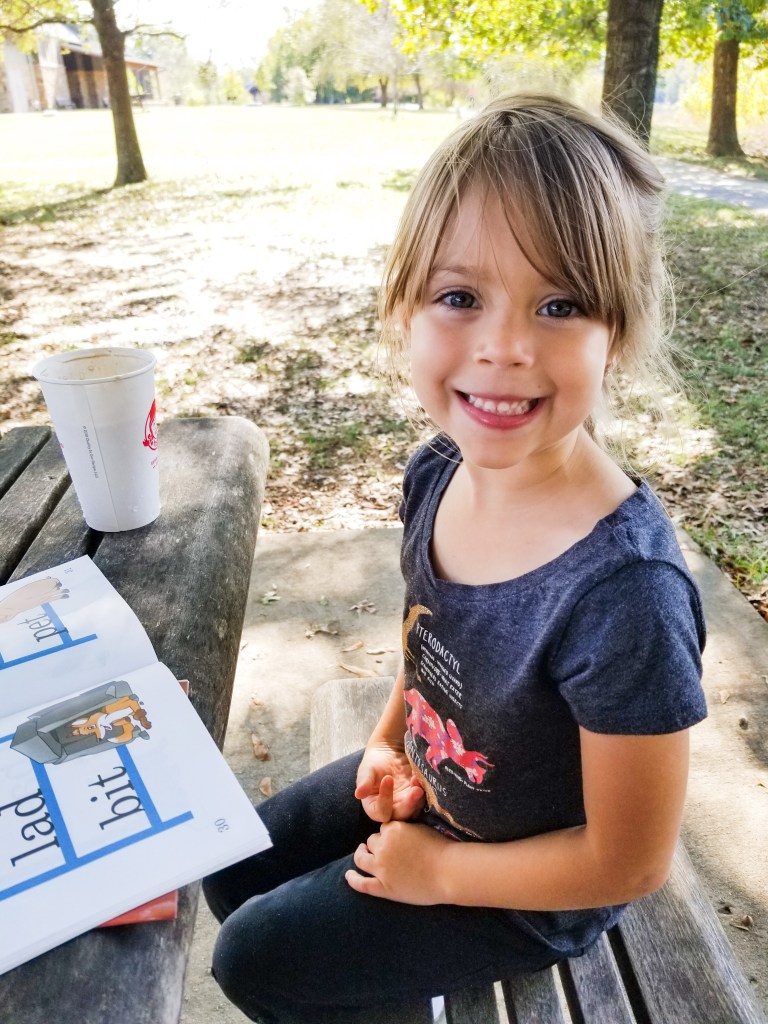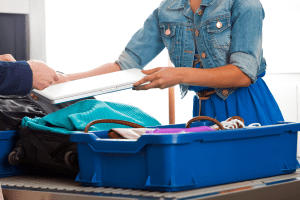With the Corona Virus pandemic going on in our world right now, a lot of parents are choosing to homeschool their kids. The fear of their kids possibly getting sick continues to grow in our country. With this overwhelming fear, I inbox has been getting numerous homeschooling questions so I figured that I should answer them all here to help guide you into this new homeschooling journey.
HOMESCHOOLING! BEFORE YOU START, KEEP THIS IN MIND!
Homeschooling is not easy at first so don’t give up right away. You need to give it a few weeks to find routine and style of schooling works best for you and your kids. It is trial and error at first but hopefully this article will help you narrow things down and find what is right for your family.
Before I start, I want to warn you that this article is pretty lengthy. You can use the table of contents tab to help you skip to the questions that you need answered right away. Sorry it is so long but I wanted to make sure I covered everything possible in this article for you to help get you started on this new journey.

Disclaimer: There are affiliate links in this post. To learn more about how affiliate links work please read our Disclosure Policy. Thank you for using our links and for your support.
1. HOW DO I GO ABOUT HOMESCHOOLING? WHAT ARE THE REQUIREMENTS FOR HOMESCHOOLING FOR MY STATE?
Most states require at least a high school diploma to be able to homeschool your kids. However, I always recommend you contact your county/district education system in your area and see what the specific requirements are for your state. A good place to start at is Homeschool Laws By State. You can find all the information you need to get started.
STATE HOMESCHOOLING REQUIREMENTS AND WHAT THEY MEAN
I am going to go over the requirements for my state of Tennessee so you can get an idea of the different types of homeschooling approaches. As for Tennessee there are 3 methods to homeschooling. These include:
- Independent homeschool – This is the one we do. Independent homeschooling also known as parent-led is when the parent does the homeschooling at home. The parent is the teacher and teaches the classes to each child. I prefer this approach because I can make sure to take it at their pace. For instance, if we are doing good on all of the classes but I see that they are struggling in one section or a certain area in one of the classes, I can take the time to focus more on that class versus rushing through it and moving on.
- Church-related school – This approach of homeschooling is geared towards a church taught school. This is when you enroll your child through an accredited Christian School. We don’t do this option but have family at Ridge Manor Christian Academy in Florida that do this approach. This is a good option for families that want their kids to have that homeschooling curriculum and also a christian school experience. It is good also for families where both parents are working and you don’t want your child to go to a public school.
- Category III distance learning school – This homeschool approach is when you buy videos or do school online through an accredited curriculum. Your child will learn at home through visuals and then sit down to do the seat work for that class.
Each state has different requirements so it is best to find what specific requirements your state has and go by that. Just make sure to read the descriptions carefully under each tab and see what best suits your family according to your states’ requirements.
2. WHAT HOMESCHOOLING CURRICULUM SHOULD I USE?
Once you have that last part figured out and have all of your paperwork filled out and turned in, it is time to pick a curriculum that you would use. First you have to see if you want to do a christian curriculum or a secular curriculum. Some christian curriculums give you the option to buy the Bible class separately so don’t get frustrated if you see a christian curriculum that you like and avoid it just cause of the christian aspect.
We use a christian curriculum so I will be going over the curriculum that we use in our home.

ABEKA
We started with Abeka for Kindergarten and First Grade because I absolutely loved how they have their Phonics, Reading, and Math set up. My daughter was reading pretty large words at the age of 5 and reading pretty clearly. I was pretty amazed by how quickly she got the hang of reading with the Abeka curriculum. Now my daughter loves to grab books and read all the time.
I started cursive at first grade with both of my daughters and it helped with their pen control. To be honest, I kind of wished I had started in Kindergarten instead. Though this isn’t my daughter’s favorite subject, I am still happy to have taught her cursive. I believe that cursive is a lost skill and her learning it will greatly benefit her in the future.
Our other favorite subject is Math. I love how Abeka breaks it down to their level and has many activities, poems, coloring, and other things making the class fun for them while also helping them learn the material for the day. My youngest actually enjoyed it so much that she finished the entire math book for Kindergarten in six months instead of 10 months. She kept asking for more sheets to do so I let her move on ahead like she was understanding the material fairly well. Once she completed her Kindergarten math book I started her in first grade math and she is still doing amazing in it.
Abeka is a Christian curriculum, however, it is not overwhelming in the christian aspect. You will find hints here and there about God but not to the point that is overbearing for you or your child so if you are looking for a secular curriculum but really like Abeka, I would highly recommend it. The Bible class is sold separately so it makes it easier to cover various styles of homeschooling families.

ROD AND STAFF BY: MILESTONES PUBLISHERS
Another curriculum that I use is Rod and Staff. I started using this curriculum last year with my oldest daughter. It is more Christian based than Abeka but my daughter likes it so far. In every class you will learn about a Christian lifestyle and even in some classes like Reading, Phonics, and English, your child will use the Bible to do their seat work and learn about the different stories in the Bible. The only part I wasn’t too happy about was some parts of their history class. Though they are Christian based it doesn’t 100% fit our Christian lifestyle. However, with some guidance and explaining about the different christian lifestyles in our world, my daughter has learned to accept everyone of any denomination, religion, and lifestyle which is good.
The main reason why we use Rod and Staff is because of their prices and the way their curriculum is set up. It is more cost effective than Abeka and I can keep the textbooks and teacher books and only purchase the workbooks for when it is time to teach that same grade to the next child. It is easily set up and pretty good paced too.
OTHER CURRICULUM RECOMMENDATIONS
I personally don’t use any of the curriculums that I am about to mention below. However, some of the other homeschool moms that I know and talk to absolutely love these curriculums and recommend them so I figured I’d share them below for you to look at.
3. WHAT HOMESCHOOLING SYSTEM DO YOU USE?
We do parent led schooling. This means that we don’t use an umbrella school, videos, online school, or any other type of school to supplement our studies. I have full control of what we do and when we do our assignments and school days. If we need to take a day off to rest, we can. If we need to take a day to play catch up or to focus in a struggle area, we can do that too.
HOW WE SET UP OUR HOMESCHOOL CURRICULUM
I use the crate system with our Abeka curriculum and the book system with the Rod and Staff curriculum. As your child gets older I find that the book system works best but for younger kids it’s easier for them to see a few sheets of paper and not feel overwhelmed by a big book.

THE CRATE SYSTEM
A crate system means that I will have a crate or file cabinet with file folders numbered from 1-170. I will then place the worksheets for each of those lesson numbers. For instance, for day 1 I will put the reading books and worksheets for Lesson 1. With Abeka is easy because every lesson is numbered at the bottom right of the page. Just tear the page out and put it in the folder.
This makes it easy because at the morning of each day you just have to grab the folder for that day and teach the class. Everything is already prepped and ready to go for you.
Here is what you need for the crate system:
- A crate or a filing cabinet
- Hanging File Folders for the months and classes.
- File Folders for the lesson plans 1-170.
THE BOOK SYSTEM
The book system means that you use a notebook and a book. I find that this system is best for older kids but it also depends on the curriculum that you are using. This is when your child uses the books, workbook, and a notebook to complete their work versus worksheets.
THE PORTFOLIO SYSTEM
I also use the portfolio system for storing all of the assignments and tests that they have done. Some states require proof of their studies. For during the school year I use a crate or filing cabinet and have a folder for each class. For after the school year has ended I just buy these file pockets and use each slot for a specific class for storing them.

4. WHAT GRADING SYSTEM DO YOU USE FOR HOMESCHOOLING?
I use the old school grading system (A, B, C, D, and F). A lot of parents are against this system but I like it and so do my daughters. They love seeing an A or a B on the top of their paper with a sticker. I can see how my daughters benefit from this grading system. They get rewarded for good grades.
HOW TO APPROACH LOWER OR FAILING GRADES
There are various ways of helping your child master a subject after they have failed a test. These are some of the approaches I have to master them. However, before even testing, I try to make sure that they are not struggling with that topic and focus more on it before even giving them the test. This is not the situation every time so here are my tips on how to master a specific topic and help them get that grade back up. Please keep in mind to always be encouraging throughout this time frame. It doesn’t mean your child is dumb or anything like that. Some subjects are just harder to master than others or even some parts of that subject. For instance, I love science but Biology is my all time favorite. However, if you give me Chemistry, I will most likely fail it.
RETESTING A FAILED TEST
If for some reason they get a lower grade such as a C, D, or F, I don’t say that they’re FAILING. If they do get a D or an F, which thank God they haven’t yet, I would tell them that they are on the lower end of the scale and we need to work harder on that topic to move back up. I would give them the chance to study again and retake the test in a few days. This is where the parent led schooling approach comes handy. I can take these next few days to focus on that class a little more or on that specific topic.
DROPPING THE TEST AT THE END OF THE SCHOOL YEAR OR REPLACING THE GRADE WITH AN ASSIGNMENT
Another thing I would do is that I would just drop it at the end of the school year or have them do an extra small assignment to replace it. This all depends on the test that she didn’t do good on and what parts of the test she struggled with.
The grading system is all up to you and your child. Just see what motivates your child most and go with that. Don’t forget to have some sort of reward system in place to help keep them motivated throughout the school year.
MY HOMESCHOOL GRADING BOOK
As for keeping track of grades, I use Google Sheets. I just grade the assignment, put the percentage in the sheet and it automatically tells me the grade she got and averages it with her other scores to give me her overall grade for the class for that year so far.
I will go more into details about this later on how you can create your own Google Sheets Grading Book.

4. HOW DO YOU KEEP YOUR KIDS MOTIVATED THROUGHOUT THE SCHOOL YEAR?
I mentioned earlier that it is good to have a reward system in place. This helps keep your child motivated and wanting to do good on all of their assignments and tests. The reward system that we use is currently is the Weekly Chore Chart for Kids. It is fully editable so you can pick and choose which chores, homeschool tasks, etc you want to add to the chart. As for homeschooling I added, do your schoolwork in a timely manner, do your schoolwork neatly, and get good grades. They get an acorn for each task they do correctly and at the end of the week they can get a reward.
CHOOSING INCENTIVES FOR THE REWARD SYSTEM
The rewards that I offer them depends on how many acorns they have earned for that week. They can get something out of the treasure box and also an extra incentive. For instance, if they only get 20 acorns for that week, they don’t get a reward. If they get anything between 20-30 acorns, they get something out of the treasure box only. Anything from 30-40 acorns and they get a goodie out of the treasure box as well as an extra incentive such as movie night. If they get 40-50 they can go to their favorite recreational place like the rock climbing gym or our local air park.
CHOOSING THE RIGHT CHORES / TASKS FOR YOUR CHILD ACCORDING TO THEIR AGE AND GRADE LEVEL
Whatever you choose for the rewards, make sure it is something that they like and are looking forward to. The more they like these incentives the harder they will work to do good and earn them. You can also use money as incentives for the very good rewards but I like to keep that for extra tasks or chores around the house. Say they want to buy a cool new toy that came out, then they can work for it by doing extra chores. Please also make sure to use only chores/tasks that are recommended for their age and that it is not too overwhelming for them either.
USE LOTS OF STICKERS
Kids love stickers. I know my girls do. Every time they finish an assignment and do good on it they get a sticker and a big smiley face at the top of their paper. I even let them choose the sticker that they want to make it more fun for them.
USE A BEHAVIOR AND MOTIVATIONAL CHART
Another item that I use throughout the day is this Behavior Chart. I love how it helps keep a visual of how they are behaving throughout the day and helps me to keep them motivated to do better as well. We usually start the day off in the middle of the chart on New Day and as the day goes on we move up or down on the chart. If they stay above New Day all throughout the week then they get an extra incentive or privilege. If they go below New Day then they get their tablet or TV taken away and have to do an extra task or chore to gain it back.
KEEP THINGS INTERESTING FOR THEM ** PLEASE KEEP THIS IN MIND DURING YOUR HOMESCHOOLING DAYS **
Please keep this in mind. This is something I have to remind myself of as well. The best thing to do is what is right for your kids!!! As long as we are learning, trying our best to make things fun and reading your kids emotions, you can have a good and well motivated day.
Don’t stress if you have to take an extra week off because you all just need a break. It’s okay. There are 365 days in the school year and you only have to report 180 of them with a minimum of 4 hours to your school district (differs by grade level and by state). Even short days count as a school day. So just make the best of every day and if you have to extend your school years, that’s okay too.
STARTING YOUR HOMESCHOOL DAY OFF RIGHT WITH A MORNING BASKET
Another way to start the day off right is by creating a morning basket. We have been slacking on this these last few weeks but it is a great and fun way to get the day started. In our morning basket we have a children’s devotion, Bible coloring pages, flash cards, our Let’s Play School FUNdamentals, and our Nature’s Homeschool Monthly Morning Basket bundle. We do different things every day from our morning basket. We usually start off with a devotion and prayer and then jump into some activities, coloring, and flashcards depending on how much time we have. I usually give a good 30 – 40 minutes for morning basket time. Some days less, others an hour give or take.
6. WHAT DO YOU DO TO SOCIALIZE YOUR KIDS WHILE YOU HOMESCHOOL?
We do a series of things to keep a social aspect in our children’s lives. My kids are pretty outgoing and love making friends so I’m not really worried about socialization to be honest. One thing you have to thing about is that kids are either born introverts or extroverts. Many kids are shy at first, even in public school. Some kids are shy all the time and that’s okay too.
Who else has met a kid when you were in school that never really talked to anyone? I know I have!

FUN SOCIAL ACTIVITIES TO DO WITH YOUR KIDS DURING YOUR HOMESCHOOL YEAR
Homeschooling doesn’t make your child weird or socially awkward. Every child is different but here are some things that you can do to help your kids make friends and have more of a social life.
- Go on field trips.
- Let them join a sport.
- Put them in a class like swimming, dance, gymnastics, etc…
- Have play dates with other parents. You can join a local homeschool group on Facebook and see about events and play dates that they may be having nearby.
- When you travel, let them make new friends. Be cautious though and never leave your child’s side or with strangers alone. Campgrounds and hiking trails are a good place to meet like minded kids.
- Join a group such as Tinkergarden, Boys/Girls Scouts, Pathfinders, Adventure Club, etc…
- Go to church and let them interact with other kids from their church class.
- Meet your neighbors and have play dates with them too.
- Attend homeschool days from local businesses in your community.
The list can go on and on.
HOMESCHOOL DAYS AND HOW TO MAKE THE BEST OF THEM
As for homeschool days, I would recommend checking out your local Facebook Homeschool Group and asking. For us, places like dance studios, rock climbing gyms, the air park, gymnastics gym, YMCA, museums, zoos, etc… all have homeschool days.
You are probably wondering what homeschool days are?! Homeschool days are a specific day of the week or the month and a specific time frame for that date set that your child can go to their location at a reduced price and meet other local kids that homeschool through doing the activities they have. Our favorite is the rock climbing gym and the air park.
PLANNING FIELD TRIPS
As for field trips I would look at the local museums, zoos, etc… and see about their homeschool days too. We like going to the Nashville Zoo for their homeschool days because they get to enjoy the animals at the zoo and also learn about them. One funny field trip we did at the Nashville Zoo was Learning About Poop. The girls learned about the different types of poops for the different animals, when to tell if the animals is close by or far away, if the animal is sick, and so on.
There are many options and ways to keep your kids socialized, especially in today’s time (if we leave the pandemic out of the picture). Please don’t let this be a worry or a concern for you. You can even talk to the school in your district and see if your child can join sports or field trips with a class there too. Some schools allow this since you are already a part of the county’s school system for your area.

7. DO WE NEED A ROOM SPECIFICALLY FOR HOMESCHOOLING?
I’ve heard people ask if they need a room specific for homeschooling their kids. NO! You don’t need a room specific for homeschooling. You can use your dining room table, a small corner in your living room, or a small desk in their rooms. Just set it up however works best for you and your kids in an area in your home.
Some people go above and beyond getting decor, dry erase board, visuals, etc. That’s okay too but if you don’t have the room I wouldn’t go all out. Here are two ways that I have set up our homeschool room. Due to being pregnancy and on a strict pelvic rest I’ve had to readjust our homeschool room. Hopefully this can give you an idea of how you can do school in just about anywhere in your home.
OUR HOMESCHOOL ROOM SET UP
As for us, we cleaned out an area in our bonus room/play room and set up a table for all of their homeschool books. I used my bookshelf to put up all of the teachers books, reading books, activity books, coloring books, and also baskets with coloring pencils, crayons, stickers, and some other art supplies. We only have one side of our bonus room for homeschooling. The other side now has a guest bed and a TV and a play area for the girls to play at.
OUR HOMESCHOOL ROOM SET UP IN THE DINING AND LIVING ROOM
Because during this pregnancy I am on a strict pelvic rest I can no longer go up the stairs to the bonus room. My husband brought down the file crate, our books for this year, our activity cart so I can set up something small down here. I went ahead and cleared two shelves on the bookshelf in our living room. The top shelf has all of our books for the year and the bottom shelf has the crate with the lesson plans, a binder for each one of the girls with their morning FUNdamentals from Let’s Play School, some laminating items, and their Bible. I also cleared an area of the dining room table for us to study. Over the days we have taken over the entire dining room table but that’s okay. As long as we are studying and learning then that is all that matters to me.
8. HOW MANY HOURS A DAY SHOULD I HOMESCHOOL MY CHILD?
This is a tough question to ask. I personally hate answering this question because every child learns at a different pace. My youngest usually knocks out all of her assignments pretty quickly while my oldest takes her sweet time finishing them. If I tell you that sometimes it takes them 2 hours to do a simple handwriting assignment you probably would be like, “What in the world?” It happens. Sometimes they can do a simple assignment quickly while other times they just don’t care to do it at all. Sometimes taking a break during these times or readjusting your focus helps.
As for how many hours a days you should do, all depends on you and your child. This can differ from day to day. As long as we do a majority of our work I will call it a day. Some days they finish it 4 or 5 hours. Other days it can be longer or shorter. It all just depends. yesterday was a short day for us. I wasn’t feeling well and was in pain due to pregnancy so we only did half a day and today we are doing another half of day to finish what we didn’t finish yesterday.
I also believe that this also depends on the curriculum that you choose. Some curriculums have more seatwork for your child to do while others have more activities or maybe even less things for your child to do. It also depends on whether you had a quick or a test that day. Usually test or quiz days are shorter for that class as well.
Just read your child’s emotions, keep them motivated and don’t give up. You got this. It is team work. Make it fun for them some days and don’t forget to take breaks as needed even if it is 5 minutes for them to wash their face or eat a snack.

9. SHOULD I TEACH CURSIVE OR MANUSCRIPT FOR HANDWRITING/PENMANSHIP?
I always recommend to teach cursive either in Kindergarten or First grade. The reason why I prefer cursive is because it teaches your child better pen control. You know all those activities they give in preschool where your child has to trace the line so they can learn pen control? Cursive works like that in a way with the loops and the slants.
However, I would also recommend your child learn manuscript too. Our main focus is cursive but both of my girls know how to write in manuscript as well. It is the first thing that they learned before moving on to cursive.
A FEW TIPS FOR TEACHING CURSIVE
- Buy the composition papers. I use Rod and Staff composition paper which you can buy here or the composition notebooks that you can buy on Amazon here.
- Use a highlighter when teaching new words or letters. I use a thin pointed highlighter and have my child trace over the highlighted words or letters to get the idea of how to write it as well as the forms and loops of them. I then place a dot next to it so they can know where to start at and write it on their own.
- Applaud with stickers. For every letter or word that looks perfect or almost perfect put a small sticker next to it. If they get, say, 100 stickers in a week, they get an extra item out of the treasure box.
BREAKING DOWN EACH LETTER INTO STEPS
- Take your time. Some letters in cursive can be tricky like the cursive r. If they need more time, skip a day or two from the regular classwork and focus those days on that letter before moving on to the next lesson. Use the highlighter method to help teach them the letter. I would do it in steps. For instance, the other day Isabelle struggled with her letter h so I split it into 3 simple steps so she can get the hang of it. The first part was going from the bottom of the line to the top of the line and make a small loop back down like an l. I did this multiple times on the paper with a highlighter and then let her do it on her own for one entire line on her paper. Then I did with highlighter step one and added the second part to the h which is when they go back up to the middle line and then back down like an n. Did half of the second line of the paper highlighted and the other half added dots for the starting point so she can do it by herself. Then for the third line I added the tail for the h which is when they go back up to halfway between the bottom and middle line. Same thing. Highlighted it for half of the third line and then placed dots. By this time she was doing the entire h.
Well I hope that these tips help you in handwriting / penmanship class. I know this is the class my girls absolutely despise but I find it to be super important. My mom always said that your handwriting says a lot about the person so that has always stuck with me.
10. WHAT PLANNER DO YOU USE AND HOW DO YOU CREATE YOUR LESSON PLANS AND PLAN AHEAD FOR THE SCHOOL YEAR?
This is another tricky question. Most curriculums already have a tentative plan in place to go with it. I tend to go by this while also adding a few homeschool days. However, I don’t plan for the entire school year. Yes I do place all of the worksheets in a crate from 1-170 but I don’t have them set up but they can be taken out for any of the week throughout the year as we progress. I do use a planner though and check off the classes that we do as we finish them each day.

THE PLANNER THAT I LOVE TO USE FROM TEACHERS PAY TEACHERS
This is the planner that we use and absolutely love. The best thing about it is that I can use it over and over again. So once I create one for a grade, I can use it again for when my other child is in that grade. I print out to two weeks ahead just in case I need to make any adjustments and put them in a clear report cover for easy viewing throughout the day. You can also put them in a small thin binder if you prefer to have them there.
FILLING OUT YOUR CALENDAR ON YOUR PLANNER
I try to plan out 9 weeks of homeschooling days at a time, so by quarters. I use a mix of the planner I linked above as well as a calendar planner. On the calendar planner I write in pencil the days I want to do. I just write a number from 1-170 for each lesson plan. Before I write in the lesson plans I write in all the holidays, field trips we want to take, vacation days, etc. Then I will fill in the rest of the days from 1-170.
Keep in mind that the county requires 180 days of school so these 10 days you don’t see in your curriculum can be test days, field trip days, days to play catch up, or just a sick day. However you would like to do it. I only fill in the lesson plans for the first 9 weeks in my calendar planner as the end of the first quarter approaches I then plan the next 9 weeks accordingly. So if we couldn’t finish all the lesson plans for those first 9 weeks, we are able to move those lesson plans up to the next 9 weeks and then fill it out around the already planned vacation days, holidays, and so on.
HOMESCHOOLING RECAP
Let’s recap real quick what we discussed above.
- Make sure to homeschool according to your states requirements.
- Make homeschooling fun but also don’t forget to educate them on the different topics.
- Take breaks during your homeschool days.
- Always plan ahead.
- Stay organized and use a planner.
- It’s okay to take a day off to focus on material that your child may be struggling on.
- It’s okay to take a break from school from time to time.
- Read your child’s emotions and lead the day by it.
- Always have a reward system in place to keep them motivated.
- It’s okay to switch curriculum or do a mix of curriculum if you don’t like it. Do what fits best for you and your family.
- Morning baskets are a great way to start the day off right.
- Cursive is perfect for pen control. I highly recommend teaching it at a young age.
- You can homeschool anywhere in your home or even at the park, beach, travels, etc…
- Have field trips, homeschool days, join a sport, etc…
- Meet local homeschooling families to make new friends in your community and have play dates.
- Homeschooling can be hard some days and very fun other days.
- Homeschooling is rewarding in it’s own way. Just pray about it and have God guide you through it.
CONCLUSION
Well these are my top 10 frequently asked homeschooling questions. If you have any other questions please don’t hesitate to ask below. I am always happy to help others in their homeschooling journey and share tips on how to get started. You can also slip into my direct messages on Facebook or even Instagram. I am always sharing homeschooling tips and stories on Instagram.
Also, if you enjoyed this article feel free to sign up for our newsletter here and get full access to our TWM Tribe Resource Library which has fun freebies and activities for you and your family.











